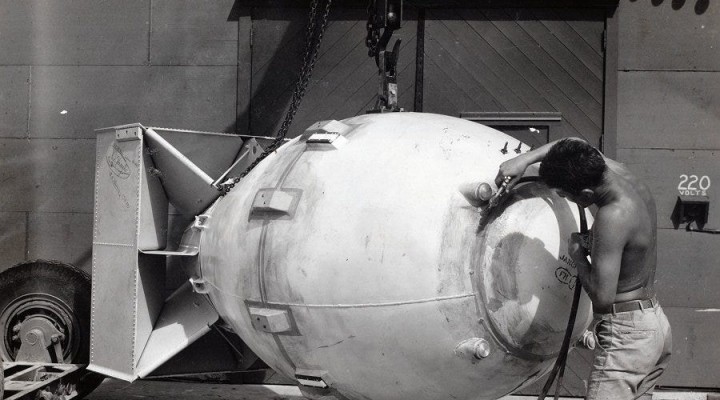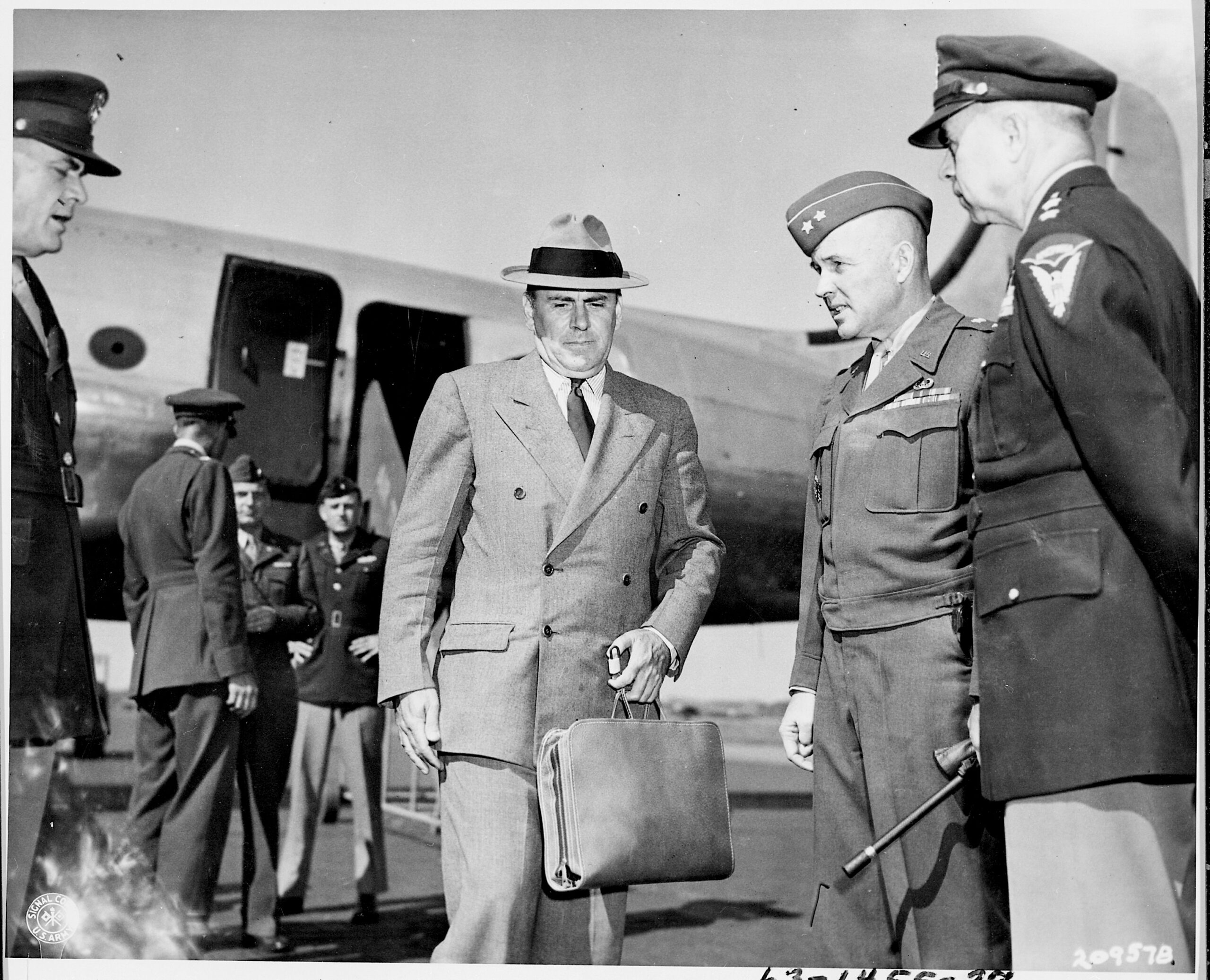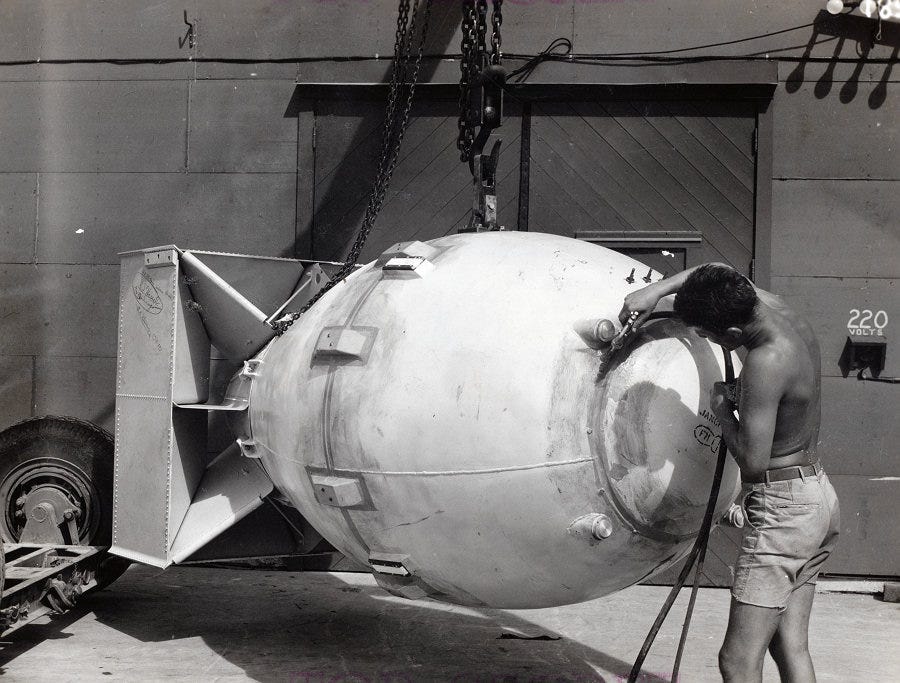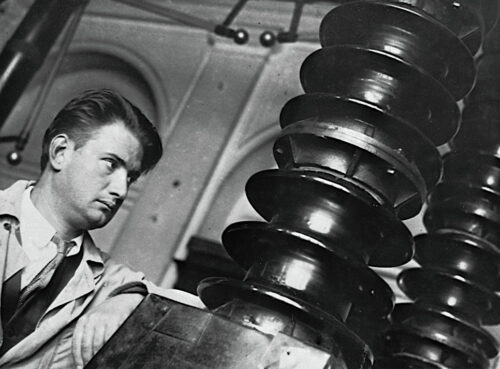ATOMIC BOMBINGS AT 75: The Decision to Drop the Bomb on Japan and the Genesis of the Cold War

The head of the Manhattan Project said, “The purpose of the whole project was to subdue the Russians,” writes Scott Ritter in this excerpt from his book Scorpion King.
(The following is taken from Scorpion King: America’s Suicidal Embrace of Nuclear Weapons from FDR to Trump, written by Scott Ritter and published by Clarity Press.)
Even by the heightened standards of a nation’s capital during wartime, the gathering of generals, admirals, and high government officials in the White House Cabinet Room on the afternoon of Monday, June 18, 1945, was impressive. Only one, however, could claim resident status—the newly sworn in president of the United States, Harry S. Truman.
A veteran of the First World War and a long-serving Democratic senator from the state of Missouri, Truman was an unlikely candidate for the job he now held. A compromise candidate for the office of vice president in 1944, Truman was no close confidant of President Franklin D. Roosevelt. Indeed, he had little insight into Roosevelt’s thinking about postwar relations with the Soviet Union and no knowledge of the existence of a major program—the Manhattan Project—to produce an atomic bomb.
In a series of meetings conducted shortly after being sworn in as president, Truman overcame this deficit, maintaining a pledge to adhere as closely as possible to the policy directions set forth by President Roosevelt. But some decisions would have to be taken by the new president, which is why he had convened the Cabinet Room meeting.
Truman Cabinet meeting at the White House, Aug. 10, 1945, one day after the atomic bombing of Nagasaki. (Abbie Rowe/Truman Library)
Joining Truman was General George Catlett Marshall, the distinguished 64-year-old chief of staff of the U.S. Army. In addition to managing the problems associated with waging global war, General Marshall was also a member of a high-level committee (the “Top Policy Group,” formed in October 1941) overseeing the effort by the United States to construct an atomic bomb.
Marshall had left most day-to-day decisions about the atomic bomb program in the hands of Major General Leslie Groves and had limited his own role to that of making sure Congress continued to underwrite the project financially and to a lesser extent of policymaking about the use of an atomic weapon.
As recently as May 31, 1945, Marshall had told a gathering of atomic bomb scientists, administrators, and policymakers that he felt the United States would be in a stronger position in any postwar environment if it avoided using an atomic bomb against the Japanese. He also recommended that the United States invite the Soviet Union to attend tests of the atomic bomb.
The majority attending that meeting ruled against Marshall, including soon-to-be Secretary of State James Byrnes, who feared the United States would lose its lead over the Soviets in nuclear weapons if the Russians became a de facto partner through such cooperation. In any event, Marshall viewed any decision to use or not use an atomic bomb, given the horrific ramifications, to be a purely political question, outside the purview of the military.
‘Barbaric’
Joining Marshall were two senior naval officers, Fleet Admiral Ernest J. King—the commander of the U.S. Fleet and chief of naval operations (the only person ever to hold such a joint command)—and Admiral William Leahy, the 70-year-old chief of staff to the commander in chief, U.S. Army and Navy. Admiral King was an abrasive, hard-drinking man who openly disdained any use of American resources for purposes other than the total destruction of the Japanese.
Unlike King, Admiral Leahy was a proponent of avoiding a bloodbath fighting the Japanese and was sympathetic toward the idea of reaching a negotiated surrender brought on by the combined pressure of an economic blockade of the Japanese islands and conventional aerial bombardment. Leahy was against any use of the atomic bomb against civilian targets, a concept he viewed as “barbaric.”
The Army Air Force was represented by Lieutenant General Ira C. Eaker. General Eaker had almost single-handedly made strategic bombing an accepted practice when as the commander of the 8th Air Force in Europe, he convinced British Prime Minister Winston Churchill to continue the controversial strategy, noting that “round the clock bombing” would “soften the Hun for land invasion and the kill.”
Ira Eaker was standing in for the flamboyant Chief of Staff of the U.S. Army Air Force, General Henry Harley “Hap” Arnold. Sidelined by health issues, General Arnold was an unabashed proponent of strategic bombing and had, through sheer force of will, positioned the Army Air Force to carry out massive aerial bombardment campaigns against both Germany and Japan.
Like Arnold, General Eaker carried the secret that it was the 20th Air Force, flying the B-29 “Superfortress” bomber, which would deliver the atomic bomb to a Japanese target should the president decide on its use.
Rounding out the meeting’s attendees was a trio of civilians. At 78 years of age, Secretary of War Henry L. Stimson was by far the senior man present. Like General Marshall, Stimson was a member of the Top Policy Group overseeing the atomic bomb project. Stimson was the first official to brief President Truman about the existence of the atomic bomb, on April 25, 1945.
At that meeting Stimson warned Truman that “with reference to this weapon, the question of sharing it with other nations and, if so shared, upon what terms, becomes a primary question of our foreign relations. Also, our leadership in the war and in the development of this weapon has placed a certain moral responsibility upon us which we cannot shirk without very serious responsibility for any disaster to civilization which it would further.”
From that meeting, Secretary Stimson, at the request of Truman, formed the “Interim Committee,” the purpose of which was to advise the president on the utility of using the atomic bomb. The Interim Committee’s report, delivered on June 1, 1945, strongly advocated for the use of the atomic bomb against the Japanese. Unlike General Marshall, who also attended the Interim Committee’s meetings, Stimson supported this decision.
Navy Secretary James Forrestal was also a member of the Interim Committee. Unlike Stimson, however, the navy secretary believed that the United States should exhaust all alternatives to dropping the atomic bomb in order to get Japan to surrender. Forrestal’s views were shaped more by his strong anticommunist position than they were out of any moral qualms about using the atomic bomb. He firmly believed that if a face-saving mechanism could be found to entice Japan into surrender, the geopolitical situation in the Pacific could be stabilized before the Soviet Union could shift its resources away from Europe.
McCloy’s Suggestion
John J. McCloy, Assistant Secretary of War, arrived at Gatow Airport in Berlin, Germany to attend the Potsdam Conference., July 15, 1945. (U.S. National Archives)
Accompanying Stimson and Forrestal was the junior civilian present, Assistant Secretary of War John J. McCloy. McCloy was a complex individual. A veteran of the First World War, McCloy served as a legal counsel for the German chemical company I. G. Farben. His links to Germany led him to be somewhat sympathetic to the rise of Adolf Hitler, whom McCloy was photographed sitting with at the 1936 Olympics in Berlin. However, his status as a lawyer and manager led to his appointment in 1941 as the assistant secretary of war.
For the bulk of the meeting, President Truman and his military chiefs wrestled with the decision to invade Japan. The battle for Okinawa was still raging, and U.S. forces there were taking upward of 35 percent losses. If this statistic held true for the initial invasion of Japan, an assault on the southern island of Kyushu, then the United States could expect to lose some 268,000 of the 766,000 troops earmarked for that operation. These statistics resonated with the president, who approved the invasion of Japan with a heavy heart.
McCloy had remained silent during the deliberations about invading Japan. Truman, who knew McCloy through his Senate work on wartime economic waste, turned to the quiet counselor and asked him to provide his opinion on these matters, especially if McCloy saw an alternative to invading Japan. McCloy responded by noting that the people in the meeting “should have our heads examined” if they didn’t explore an alternative other than yet another island assault to ending the war with Japan.
Truman asked McCloy to explain himself, and McCloy did so, emphasizing a diplomatic solution over the classic military endgame of “unconditional surrender.” “Some communication to the Japanese government which would spell out the terms that we would settle for,” McCloy told the president, “there would be a surrender. I wouldn’t use again the term ‘unconditional surrender,’ but it would be a surrender that would mean that we would get all the important things that we were fighting for if we could accomplish our objectives without further bloodshed, there was no reason why we shouldn’t attempt to do it.”
McCloy implored the president to find a way to remind the Japanese of America’s overwhelming superiority in arms. He also suggested that the United States should show some flexibility when it came to allowing the Japanese to retain their traditional form of government, including the institution of the emperor.
Then John McCloy said something that stunned everyone in the room: why not tell the Japanese that America had the atomic bomb? If Japan would not capitulate in the face of overwhelming military superiority and a diplomatic concession on the issue of the emperor, then surely they would surrender knowing the United States had the means and the will to destroy their cities with this new, horrible weapon.
McCloy’s comments prompted President Truman to have the assistant secretary of war take his diplomatic concepts to the State Department for consideration by the secretary of state–designate, James Byrnes. McCloy’s intent was on how to avoid invading, as well as dropping the atom bomb on, Japan. But Byrnes had other concerns beyond Japan. In May 1945, while he awaited his formal appointment as secretary of state, Byrnes met with one of the Manhattan Project physicists, the Hungarian-born Leo Szilard.
Impressing Russia
Left to right: Military Aide General Harry H. Vaughan, Josef Stalin, President Harry S. Truman, Andrei Gromyko, Press Secretary Charles G. Ross, Secretary of State James F. Byrnes and Vacheslav Molotov. They are at the Little White House, the residence of President Truman during the Potsdam Conference. (Truman Library)
According to Szilard, Byrnes was very concerned about the role of the Soviet Union in the postwar era. The Soviets’ massive armies had already steamrolled into Eastern Europe, and America was faced with the difficult task of figuring out how to get them out of these nations after Hitler was defeated. Byrnes told Szilard “that Russia might be more manageable if impressed by American military might, and that a demonstration of the bomb might impress Russia.”
Focused more on containing the Soviet Union than defeating Japan, Byrnes rejected McCloy’s proposals about how best to proceed concerning the atomic bomb. Germany had surrendered, and Japan was on the verge of a similar capitulation. America’s looming problem was Russia, and Byrnes wanted the atomic bomb up his sleeve when advising the president on that matter.
James Byrnes was appointed secretary of state on July 3, 1945. His first major task was to prepare President Truman for the upcoming Potsdam summit. Japan was not the first issue on his mind; Russia was. The basic decision as to whether an atomic bomb was to be dropped on Japan had already been made by early July 1945, prior to Byrnes being sworn in as Secretary of State.
McCloy had not succeeded in his efforts to dissuade the President from this course of action. An Interim Committee meeting held on July 6, 1945, noted that the matter of discussing the existence of an atomic bomb at the upcoming “Big 3” meeting was particularly urgent, given the short timeline between that meeting and the actual use of the weapon. According to the mindset of the Americans, the atomic bomb played a critical role in shaping the postwar world that was being planned in Potsdam.
An undercurrent sweeping the mood of the entire nation in the summer of 1945, unnoticed by many modern observers, was one of national exhaustion. Congressional pressure exerted in the aftermath of Germany’s surrender in May 1945 not only resulted in 450,000 troops being demobilized in the European theater even while war raged in the Pacific but also in an additional 30,000 being demobilized in the Pacific as well. America was having trouble in staying the course against Japan, let alone positioning itself to contain and control the Soviet Union in a postwar world.
Only the secret of the atomic bomb changed the calculus of global power diplomacy.
McCloy and those assembled in the White House on June 18, 1945, were not the only ones in America concerned about the atomic bomb project and its impact on a world at war. In Los Alamos, the birthplace of the atomic bomb, many of the Manhattan Project scientists were likewise growing increasingly alarmed over the terrible weapon they were preparing to unleash on an unsuspecting people.
The polar cap of the Fat Man weapon being sprayed with plastic spray paint in front of Assembly Building Number 2 on Tinian Island. (U.S. National Archives)
As early as March 1944 these scientists were coming together in informal social gatherings held in their secret base of operations, where the issue of how best to use this new and terrible technology was discussed. One such meeting involved the Manhattan Project’s military chief, General Groves.
The Franck Report
After a dinner with the head of the British mission to Los Alamos, James Chadwick, and Joseph Rotblat, a junior British physicist (and future founder of the Pugwash Conferences on disarmament, work that won him the Nobel Peace Prize in 1995), Groves offered his views on postwar Europe. As Rotblat recalled, Groves informed the two Brits that “the whole purpose of the project was to subdue the Russians.”
Rotblat wasn’t the only scientist involved with the Manhattan Project who was concerned about the reality of an atomic bomb. At the University of Chicago, where Enrico Fermi first sustained a fission reaction, the “Chicago Scientists” formed several committees to study the implications of an atomic bomb.
One of these, the Committee on Social and Political Implications, headed by James Franck, a German Jew distrustful of government control over science, published a report in June 1945 known as the “Franck Report,” which detailed the consequences of embarking on policies that would lead to a nuclear arms race.
The Franck Report cautioned against viewing the atomic bomb as a possible means of leverage against the Soviet Union, emphasizing that the United States could not
“hope to avoid a nuclear armament race, either by keeping secret from the competing nations the basic scientific facts of nuclear power, or by cornering the raw materials required for such a race—if no efficient international agreement is achieved, the race of nuclear armaments will be on in earnest not later than the morning after our first demonstration of the existence of nuclear weapons.”
Unfortunately for the Chicago Scientists, the die was already cast. At 5:45 a.m. on July 16, 1945, in a remote desert site near Alamogordo, New Mexico, the world’s first atomic explosion occurred. “Trinity,” as the test of the plutonium-core implosion device was known, proved the viability of the atomic bomb concept and in doing so forever changed the world.
A plaque at the site of Trinity nuclear test on July 16, 1945.
President Truman was already in Potsdam at the time of the Trinity test, awaiting the summit with Joseph Stalin and the British (Winston Churchill was initially present at Potsdam, but given the victory of Clement Atlee in the July British parliamentary elections, was replaced by the latter on July 27, 1945). The Potsdam conference was primarily designed to address the issue of postwar Europe, in particular how best to deal with a defeated Germany and how best to guide the recovery of Europe as a whole.
On July 17, during their initial meeting, Stalin and Truman set forth their respective positions. Truman was not happy with the Soviet leader’s hardline stance on Poland and other Eastern European countries, but privately gloated about what he termed his own “dynamite” secret—the atomic bomb (Truman had been notified about Trinity on July 16). Truman initially embraced the Russian decision to enter the war against Japan by August 15, but by the conference’s end the president was hoping that the use of the atomic bomb against Japan might compel the Japanese to surrender before the Russians could initiate a land grab in Asia that rivaled that underway in Europe.
On July 24, Truman mentioned to Stalin, in a very casual manner, that the United States “had a new weapon of unusual destructive force.” According to Truman, “The Russian Premier showed no special interest. All he said was he was glad to hear it and hoped we would make ‘good use of it against the Japanese.’” To Truman and those who observed this exchange from the United States and Great Britain, it seemed that Stalin did not comprehend the enormity of what Truman had told him.
Soviet Bomb Project
Kurchatov as employee of the Radium Institute in 1939. (Wikipedia)
Nothing could have been further from the truth. Regardless of the desires of the United States and Great Britain to keep the secret of the atomic bomb from Stalin and the Russians during the Second World War, the fact is that the Soviets were all too aware of what was transpiring inside the secret weapons plants in the United States and Britain.
As early as 1942, the Soviet intelligence system had become aware of the existence of the American nuclear weapons program. Armed with this intelligence, Levrenti Beria, Stalin’s ruthless head of intelligence and security, was able to convince Stalin that Russia needed to embark on its own path toward acquiring the atomic bomb.
In September 1942, Stalin concurred, and a handpicked team of Soviet physicists, led by Igor Kurchatov, set about constructing the Russian equivalent of Los Alamos at an abandoned monastery outside the city of Sarov, which would become known only by its postal code, Arzamas-16.
Immediately upon his return to his quarters following his conversation with Truman, Stalin summoned Foreign Minister Vyacheslav Molotov and Marshall Georgi Zhukov and informed them of what Truman had said. Far from misunderstanding Truman, Stalin spoke of the atomic bomb and sent instructions to Kurchatov to “speed things up.” Because of the work of Soviet intelligence, Stalin knew that the United States only had one or two atomic bombs in its possession. But even this limited arsenal was reason for the Soviet leader to be concerned.
On July 25, the day after his conversation with Stalin, President Truman signed off on the final decision to drop the atomic bomb on Japan. On August 6, 1945, the B-29 Superfortress nicknamed the Enola Gay delivered its deadly cargo over the Japanese city of Hiroshima, immediately killing tens of thousands of Japanese, mostly civilians, and ushering in the age of atomic annihilation.
Stalin, fearful that the United States would seek to use its atomic monopoly to limit Soviet options in postwar Asia, immediately advanced the date of the Soviet declaration of war again Japan to August 8. The U.S. decision to bomb Japan a second time, also on August 8, resulting in the obliteration of the city of Nagasaki and tens of thousands of its citizens, further reinforced the Soviet paranoia that, as Marshall Zhukov noted, “The U.S. Government intended to use the atomic weapon for the purpose of achieving its Imperialist goals from a position of strength in ‘the cold war.’”
In response, on August 20, 1945, Stalin ordered Lavrenti Beria to head up a “Special Committee on the Atomic Bomb” in order to build a Russian counter to the American bomb. Stalin’s concerns about American abuse of the atomic bomb were not born purely from paranoia.
By August 30, 1945, a scant twenty-two days after the Japanese city of Hiroshima was subjected to nuclear holocaust, and ten days after Stalin ordered the acceleration of the Soviet bomb project, General Leslie Groves was presented with a document that listed Soviet cities and industrial facilities, along with a calculation as to how many atomic bombs would be required to destroy each targeted area (Moscow and Leningrad were each assigned six atomic bombs).
The atomic bomb had created the illusion of “war made easy,” even as some of the architects of the nuclear assault on Japan were getting a firsthand look at what destruction they had wrought.
ATOMIC BOMBINGS AT 75: The Decision to Drop the Bomb on Japan and the Genesis of the Cold War
 TheAltWorld
TheAltWorld 







0 thoughts on “ATOMIC BOMBINGS AT 75: The Decision to Drop the Bomb on Japan and the Genesis of the Cold War”